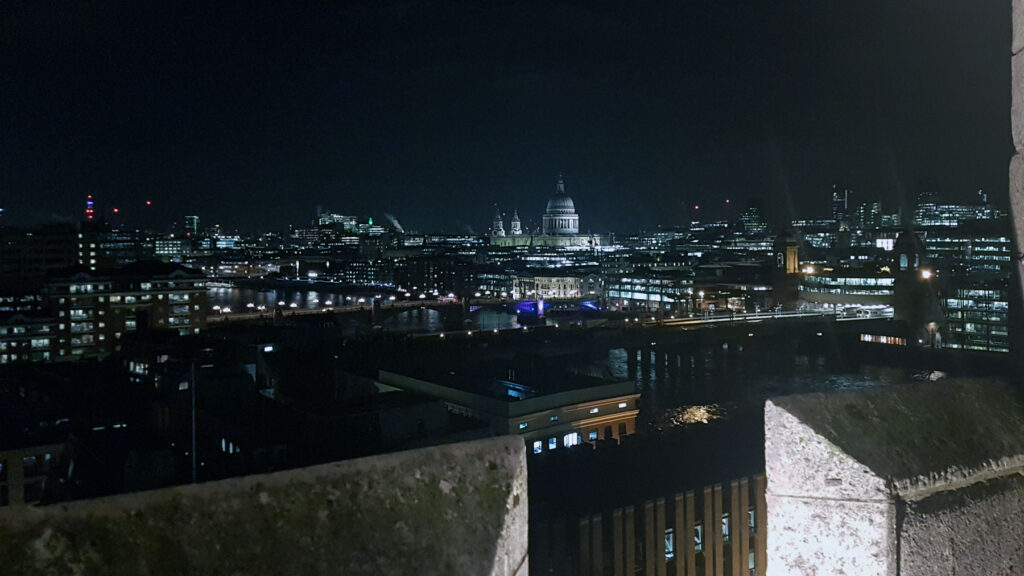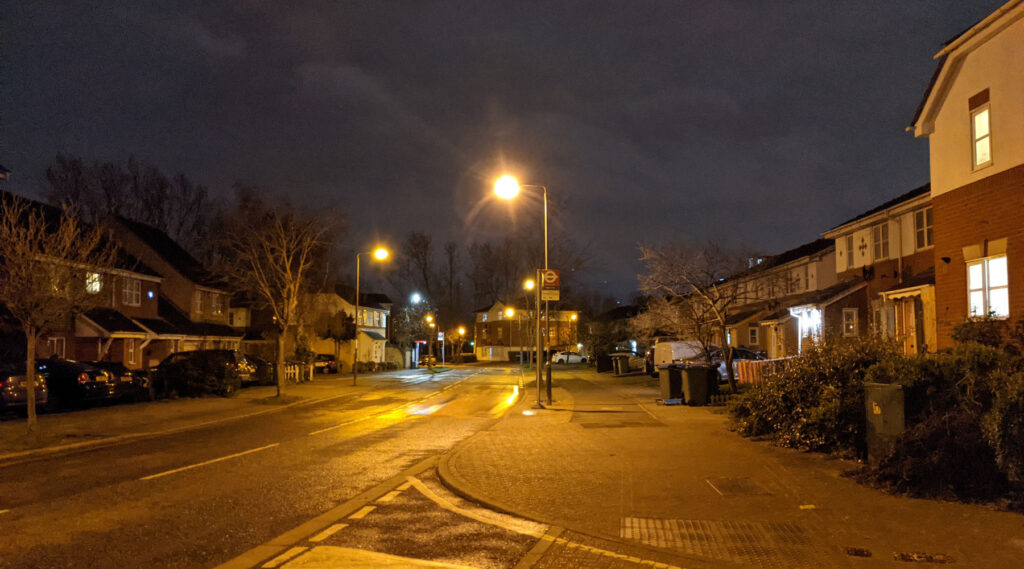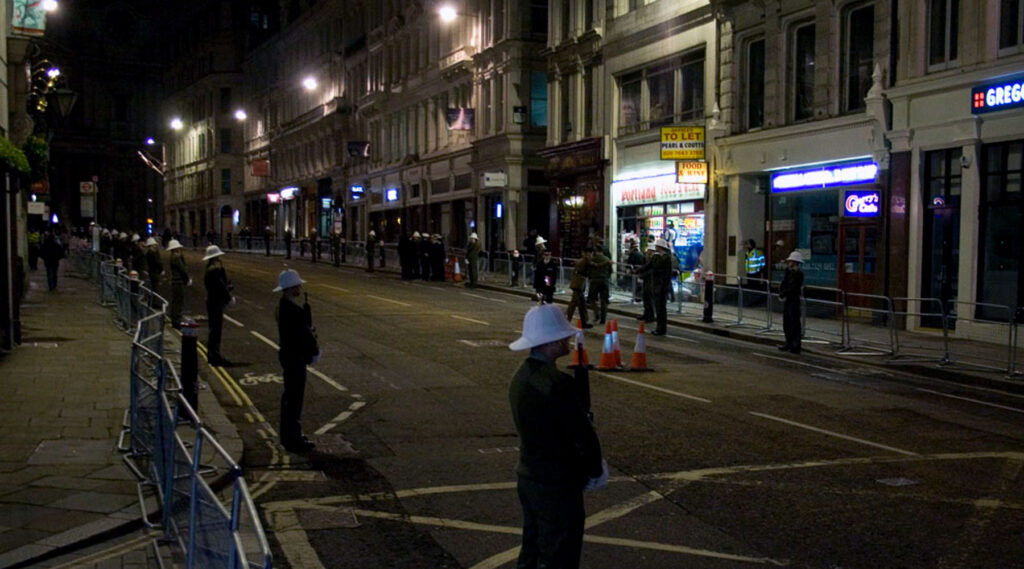Anyone who has wandered around at night can’t help but notice the contrast between an effective, but decoratively lit heritage area and generic suburbs with streetlamps flooding streets in a sickly orange haze.
Some of this is legacy, old lamps not being replaced, but mainly due to a lack of policies that actively improve the appearance of the urban landscape at night.
A report by the think tank, the Centre for London has taken a look at how London’s street lights are planned and calls for there to be more thought given to how street lighting is planned in future.
The advent of modern LED lights and the actions of councils to replace old lights with newer lower energy bulbs offers a unique opportunity to rethink how the city is illuminated at night. Not just to make it safe, but appealing in its own right.
New lighting also offers the opportunity to improve the night sky, by reducing the amount of light needlessly beaming into the sky and hiding nature’s own lighting system, the stars. Not just the bulbs and fittings, but also ensuring that bright downlighters aren’t so bright that they reflect much of their illumination off the pavement and back into the sky.
A lot of this is simple to implement, but requires more work by councils to coordinate plans so that it is implemented.
An example that has often struck me, mainly by not being struck by them when walking around the City of London is how few lampposts there are in the City. Have you ever noticed that they’re almost non-existent? That’s because most of the street lighting is mounted on the buildings. More space for pedestrians, a cleaner pavement space, and downlighting reflecting off walls usually looks more decorative than big bulbs on poles.
Take it one step further and rather than simple wall-mounted lamps, turn the street lighting into decoration as well. Highlight the parts of buildings that can be highlighted, and rather than a street of reasonably uniform lumens lighting up everything.
I live in an estate of old buildings, many of which have decorative lighting mounted on them — and we have street lighting that almost obscures the effect. How much nicer to replace the garish sodium lamps with something more carefully thought out so that there can be better lighting.
Street safety would be improved not diminished by replacing these orange floodlights with, for example, ground-level lamps that illuminate the spaces behind bushes and recesses in doorways.
And it’ll look nicer as well.
One of the best times, I think, to photograph an urban area is twilight, when the lights are coming on, but you can still see the details of the buildings. Once the sun has set, the urban landscape is nothing more than dark shadows framing blocks of glowing windows. All the decoration has gone. How much more wonderful it would be to start looking at the decoration on the walls of buildings as something to be shared at night as much as during the day. Swap a few of the streetlamps outside the building with an equal but so much more enjoyable amount of lighting on the building.
The wonders we could see, as buildings come alive at night with whole new perspectives on their facades, and wandering the streets at night would be a delight of discoveries.
Not just the urban core, but suburbs would be so much more interesting and feel safer if bland floodlighting was replaced with more strategic lights. At the moment, a suburban street often feels like an orange canyon between unwelcoming houses with closed curtains, and yet it could be a space that’s had the lighting used to accentuate the key elements such as bus stops and junctions, destroy the hiding spaces, and make the suburb more welcoming.
Aside from street lights, there’s commercial lighting to deal with. Offices that are clearly not in use with lighting flooding out of the floor to ceiling windows and shops advertising to customers who are tucked up in bed. Obviously, some lighting is needed for internal security, but walking around some shopping areas at night requires sunglasses.
And it’s not decorative, just a shabby security guard.
I used to work in retail stores and we used to be clever with our security lighting We focused just a few spotlights inside the shop on sales signs and key areas to promote, so that it was still secure, functioning as a sales tool, and in its way, quite decorative.
Improving the way streets are lit at night can be done, is usually remarkably cheap to achieve, and with the ongoing swapping of lights for LEDs, this is an exceptional time to improve the whole urban nightscape.
As the Centre for London report notes, London is largely missing out on these opportunities because it lacks a city-wide strategic approach to lighting and good design principles are often ignored. Only two of London’s 33 local authorities even have a lighting strategy.
If councils gave more thought to how lighting is delivered beyond simply siting a pole in the pavement, more people would feel safer walking around at night, and would want to walk around at night.
The full report is here.
Addendum – after I wrote this article, but before it was published, Harringay council announced plans to replace 18,600 streetlights. I wonder if they will read the Centre for London report first.










I just hope councils go for a warmer temperature of lighting, somewhere around 3000K would be perfect. Too many retrofitted street lamps where they’ve just plonked a ghastly, harsh daylight bulb in and called it a day. Really bad for wildlife too.
I can read the parking sign across the road from my bedroom because it is like daylight. Absolutely can’t sleep after the local council captured a bit of the sun at the crack of dawn and installed it outside my window.
Just a thought on the LED lights: I find that the newer LED lights used in public spaces are often unnecessarily bright and I think they increase light pollution. I also dislike how ‘cold’ the colour of the LED lights used are, it feels very clinical to me. Perhaps I am just more sensitive to light but I do find that the increase in the use of cold LED lighting actually often makes the lighting worse. Obviously I am in favour of more efficient lighting but I would love to see a warmer tone of LED light used and with a more appropriate level of brightness for better ambience in public spaces where they are used.
So basically you’re agreeing that bad lighting is bad and good lighting could be good.
Badly installed LEDs are going to be bad, and well planned LEDs are going to be good.
i’m wondering how young you re, b/c the garish yellow light that came before LEDs were worse.. i’m guessing that fine tuning lighting is not as easy as once made out to be.
Even boroughs have vastly different ideas of what constitutes good lighting. Walk down Enfield or Southgate high street at night and it’s fine, even pleasant.
Walk down Fore street in Enfield and you’re just waiting to be ambushed by baddies. The most Street lighting there is provided by the Halifax bank window display.
Is about time that the council take steps to put lights in dark places . 12 years ago I called Wandsworth council to put some lights in our cule de sac they refused there are 12 houses in this little private road and all of them pay council tax it was so dark spescialy during winter that you had to use torch i bought a large garden light and asked an electrician to put it up since then I’m paying for the light . I hope the council would change their rule and put a proper light in this little private road .
Private Road – that’s why the council refused to do anything.
They aren’t responsible for unadopted streets and that includes provision of street lighting.
Just because it says eco on the box is unfortunately not a guarantee that it’s better on every front of course.
When they changed over the bulbs in traffic lights to LEDs I found that it took some getting used to. They were/are so sharply bright that I felt them slicing into my eyes somehow.
If ever there were needed proof that the go-to “clear/bright/cool” white LEDs are a poor second best, compare their price with the just as illuminating “warm” white versions which have been generally more expensive.
The village of Weeting on the norfolk/suffolk border has had parts of it sodium lamp lighting replaced with LED lamps for several years now. The reduction in light pollution is very welcome, the orange glow of sodium lamps would creep in past curtains, illuminating bedrooms at night making it harder to get to sleep if stress levels were mildly higher than normal. Sure there are parts between each lamp which is now in darkness, but you can see if people are loitering in the shadows because they silhouette the lamps behind them. The Police also have a say over the design of new build estates and other building complexes for the obvious crime reduction and prevention they want to see, just checking out planning portals to see what your local constabulary have to say on some planning applications. All in all I’m in favour of LED street lights for reducing the light pollution, the only thing to caution against is the narrow band of light frequency can affect eyesight and I’ve not seen any scientific studies looking into this yet.
Street lighting is very wasteful of money energy, while the illumination of public buildings, bridges and monuments, etc., just to provide eye-candy to the proletariat serves no useful purpose, and should be stopped.
So what is the solution?
In quiet residential and suburban areas street lighting should be motion operated and subject to an 11p.m. till dawn curfew. These were standard practice until 1969. The luminaires should be fully recessed, and not exceed a luminosity of 400 lumens, nor should they exceed a colour temperature of 1750K. In areas with a low risk of vandalism robust low level bollard lighting may be more appropriate. There will ge no loss of amenity if these measures are adopted.
In rural areas street lighting should not be permitted, in order to maintain the distinction between town and country. It is now well established that light at night exposure is not only harmful to humans through melatonin supression, but also to other living things. It eliminates insect populations, and this will have concomitant effects on higher order consumers and the pollination of plants.
We must get over this urban myth that street lighting reduces crime. It doesn’t, and where street lighting curfews have been re-introduced criminality has declined by as much as fifty percent. During power failures it almost vanished, ergo criminals need light. Consequently we are actually safer under a blanket of darkness.
We must realise that darkness at night is normal, so we should cherish and respect it.
As I understand it, many (all?) London Boroughs are on PFI contracts to provide lighting,when lampposts may have been relocated to a higher density.
They are utilitarian lamposts (some pseudo ‘Heritage) posts in key areas) and originally High Pressure Sodium (pale orange), to replace old Low Pressure Sodium (deep orange) and decaying concrete posts from the 60’s,
Now being upgraded to LED as the increased number of lamps are too expensive to run, plus centralised control so that they can – in theory – be dimmed or turned off at certain times.
I’m also seeing council blocks being mounted with – High Pressure Sodium Lamps!, where the street lamps have just been converted to LED’s!
I have seen old lampposts in towns outside the London Boundary upgraded to LED – the posts are often low and the LEDs don’t spread so it’s darker between the posts.
So joined up thinking to plan lighting to improve security, reduce light pollution, create ambience, reduce cost etc. whilst the light blares out from all those 15-30 storey apartments going up everywhere? I suspect not…